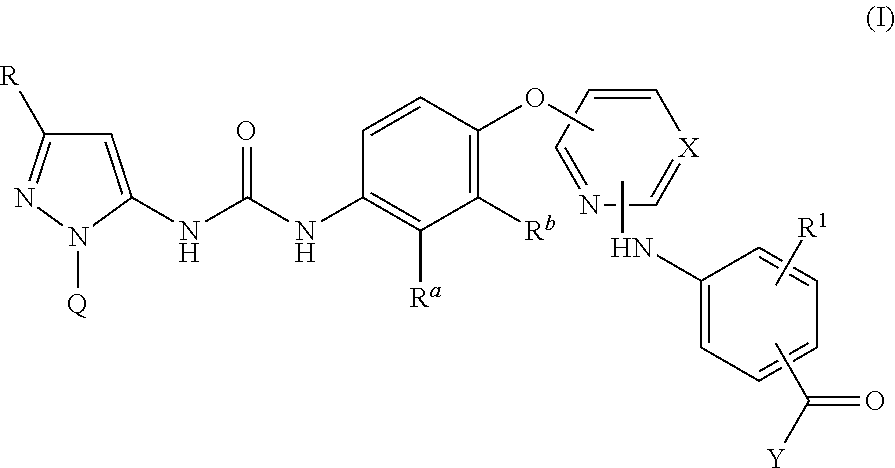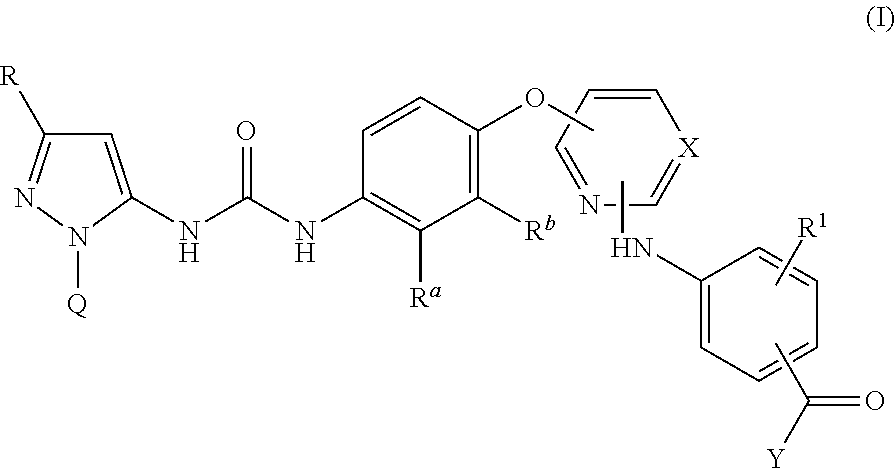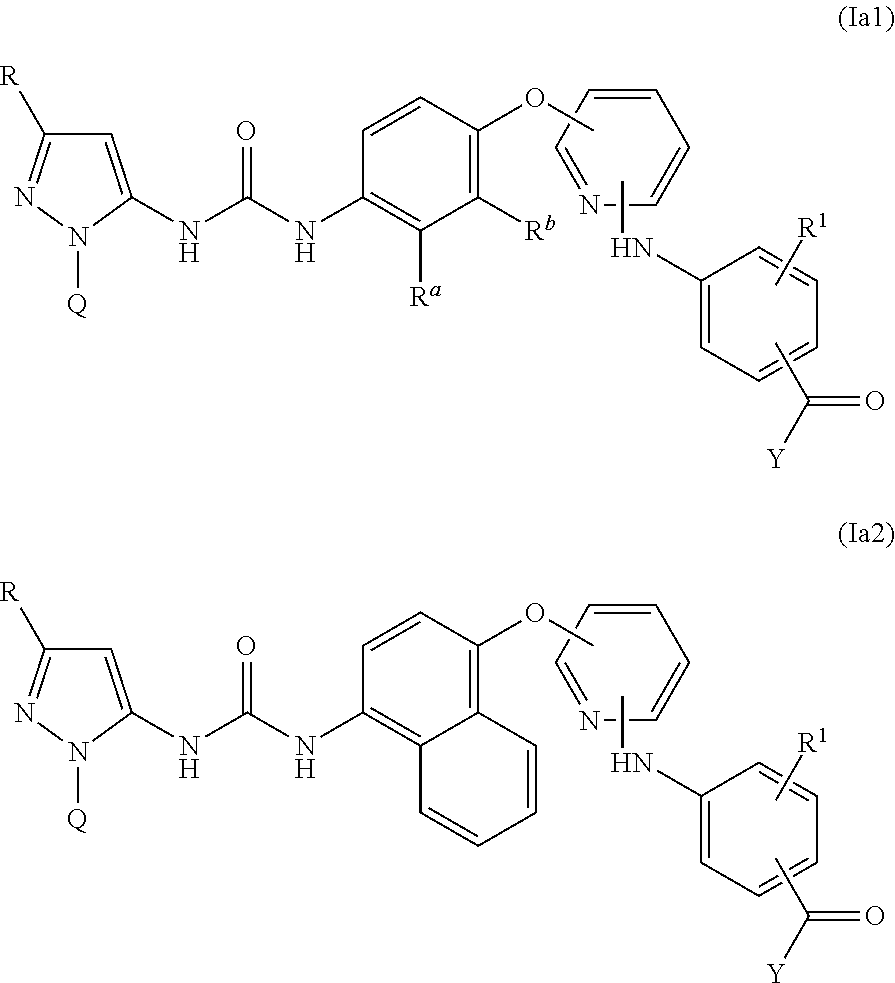Kinase inhibitors
a technology of kinase inhibitors and inhibitors, applied in the field of kinase inhibitors, can solve the problems of multiple off-target effects, high toxicity, and discontinuation of the development of a substantial number of inhibitors, and achieve the effect of enhancing the therapeutic profile and low affinity
- Summary
- Abstract
- Description
- Claims
- Application Information
AI Technical Summary
Benefits of technology
Problems solved by technology
Method used
Image
Examples
example 1
3-Ethynyl-5-((4-((4-(3-(3-isopropyl-1-(p-tolyl)-1H-pyrazol-5-yl)ureido)-naphthalen-1-yl)oxy)pyrimidin-2-yl)amino)-N-(2-(2-(2-methoxyethoxy)ethoxy)ethyl)-benzamide
[0560]
[0561]Intermediate C1 (146 mg, 0.285 mmol) was dissolved in DMF (3 mL) and added to Intermediate D2 (87 mg, 0.285 mmol) and p-TSA monohydrate (27.1 mg, 0.142 mmol). Stirred at 70° C. (block temperature) for 7 h then poured into sat. NaHCO3 solution (20 mL) and the product extracted with EtOAc (2×20 mL). Organics bulked and washed with 20% w / w brine solution (20 mL), dried (MgSO4), filtered and evaporated to a yellow solid. The crude product was preabsorbed onto silica (4 g) and purified by chromatography on silica gel (40 g column, 1% MeOH:DCM to 6%) to afford a pale brown solid. Triturated 4 times with MeCN (2 mL) to afford the title compound (60 mg)
[0562]1H NMR (400 MHz, DMSO-d6) δ 9.76 (s, 1H), 9.09 (s, 1H), 8.78 (s, 1H), 8.51-8.40 (m, 2H), 8.13-8.01 (m, 2H), 7.94 (d, 1H), 7.87 (s, 1H), 7.82 (d, 1H), 7.68-7.54 (m, ...
example 2
3-((4-((4-(3-(3-(tert-Butyl)-1-(p-tolyl)-1H-pyrazol-5-yl)ureido)naphthalen-1-yl)oxy)pyrimidin-2-yl)amino)-5-ethynyl-N-(2-(2-(2-methoxyethoxy)ethoxy)ethyl)-benzamide
[0564]
Method 1
[0565]A suspension of Intermediate C2 (165 mg, 0.282 mmol), Intermediate D2 (173 mg, 0.564 mmol) and p-TSA monohydrate (11.0 mg, 0.058 mmol) in THF / DMF (6 mL, 1:2) was heated at 60° C. overnight. The reaction was cooled to rt and partitioned between EtOAc (40 mL) and sat. aq. NaHCO3 (30 mL). The aqueous layer was extracted with EtOAc (2×40 mL). The combined organic extracts were washed with water (2×50 mL), brine (2×50 mL), dried (MgSO4), filtered and concentrated in vacuo. The crude product was purified by chromatography on silica gel (40 g column, 0-10% MeOH) to afford a pale yellow solid. The solid was triturated with EtOAc affording the title compound (68 mg) as a white solid.
[0566]1H NMR (DMSO-d6) 400 MHz, δ: 9.75 (s, 1H), 9.08 (s, 1H), 8.76 (s, 1H), 8.43-8.46 (m, 2H), 8.06-8.08 (m, 2H), 7.94 (d, 1H), 7...
example 3
3-((4-((4-(3-(3-(tert-Butyl)-1-(4-methoxyphenyl)-1H-pyrazol-5-yl)ureido)-naphthalen-1-yl)oxy)pyrimidin-2-yl)amino)-5-ethynyl-N-(2-(2-(2-methoxyethoxy)-ethoxy)ethyl)benzamide
[0569]
[0570]To a stirred solution of Intermediate C3 (175 mg, 0.316 mmol) and Intermediate D2 (153 mg, 0.474 mmol) in DMF (4 mL) was added p-TSA monohydrate (30 mg, 0.158 mmol). The resulting solution was heated at 60° C. overnight. The reaction was cooled to rt and partitioned between EtOAc (30 mL) and sat aq. NaHCO3 (30 mL). The aqueous phase was back extracted with EtOAc (30 mL). The combined organic extracts were washed with water (2×50 mL), brine (50 mL), dried (MgSO4), filtered and concentrated in vacuo to afford an orange oil (276 mg) at 85% purity. The crude product was purified by chromatography on silica gel (40 g column, 0-10% MeOH in DCM) to afford a pink solid (188 mg), which was triturated with MeCN to afford the title compound (98 mg) as an off-white solid.
[0571]1H NMR (DMSO-d6) 400 MHz, δ: 9.75 (s...
PUM
| Property | Measurement | Unit |
|---|---|---|
| temperatures | aaaaa | aaaaa |
| temperatures | aaaaa | aaaaa |
| temperature | aaaaa | aaaaa |
Abstract
Description
Claims
Application Information
 Login to View More
Login to View More - R&D
- Intellectual Property
- Life Sciences
- Materials
- Tech Scout
- Unparalleled Data Quality
- Higher Quality Content
- 60% Fewer Hallucinations
Browse by: Latest US Patents, China's latest patents, Technical Efficacy Thesaurus, Application Domain, Technology Topic, Popular Technical Reports.
© 2025 PatSnap. All rights reserved.Legal|Privacy policy|Modern Slavery Act Transparency Statement|Sitemap|About US| Contact US: help@patsnap.com



